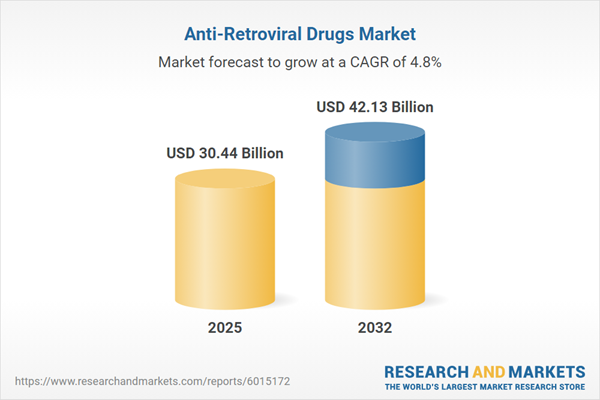Speak directly to the analyst to clarify any post sales queries you may have.
The antiretroviral drugs market is evolving rapidly, shaped by advances in treatment delivery, digital health solutions, and a global push toward accessible care. Senior executives face a complex landscape requiring data-driven strategies to foster innovation, streamline operations, and ensure patient-centric outcomes.
Market Snapshot: Antiretroviral Drugs Market Size and Growth
The antiretroviral drugs market is demonstrating steady and sustained expansion, with a global valuation anticipated to reach USD 29.05 billion in 2024 and projected at USD 30.44 billion for 2025. This sector’s growth, underpinned by a 4.75% compound annual growth rate, is forecast to achieve USD 42.13 billion by 2032. Key drivers include ongoing investment in research and development, implementation of advanced therapy modalities, and significant improvements in international supply chains. Regulatory activity, strategic business partnerships, and robust awareness and access initiatives collectively support an optimistic market trajectory.
Scope & Segmentation: Strategic Overview of the Antiretroviral Drugs Market
This report presents a comprehensive segmentation framework to enable effective resource planning and market positioning for industry leaders. Deep understanding of each segment streamlines tailored strategies for organizations adapting to evolving therapies and regional market dynamics.
- Product Types: CCR5 antagonists, fusion inhibitors, integrase strand transfer inhibitors, non-nucleoside and nucleoside reverse transcriptase inhibitors, and protease inhibitors, offering diversified treatment protocols for HIV and related infections.
- Routes of Administration: Oral and parenteral options facilitate adaptation to diverse clinical workflows and patient requirements.
- Formulations: Injectable, intravenous, subcutaneous, oral solids (tablets, capsules), and oral liquids (solutions, suspensions) reflecting a shift to user-friendly drug delivery.
- End Users: Home care environments, hospitals, and specialized clinics to support both centralized and decentralized care models.
- Distribution Channels: Hospital, retail, and online pharmacies, mirroring ongoing advancements in digitized supply chain practices and omni-channel delivery tactics.
- Therapy Lines: First line, second line, and salvage therapy levels, supporting chronic and resistant case management across varied populations.
- Patient Groups: Adult and pediatric populations, enabling precisely tailored therapeutic and commercial decisions.
- Geographic Coverage: Americas, Europe, Middle East & Africa, and Asia-Pacific, recognizing regulatory diversity and regional healthcare infrastructure for effective benchmarking.
- Key Companies: Leading market participants include Gilead Sciences, ViiV Healthcare, Johnson & Johnson, Merck, Bristol-Myers Squibb, Teva, Viatris, Cipla, Aurobindo Pharma, and Lupin, providing insights for competitive assessment and partnership potential.
Key Takeaways for Senior Decision-Makers
- Long-acting and implantable formulations are improving patient adherence, supporting management strategies in both clinical and home care scenarios.
- Emerging approaches such as gene editing and broadly neutralizing antibodies are reshaping clinical practices and enhancing care standards.
- Integration of digital tools, including telemedicine and remote monitoring, is boosting patient engagement and expanding care reach in regions with limited infrastructure.
- Evolution in pharmacy distribution, with an emphasis on local manufacturing and digital order flow, helps maintain reliability and market access during supply chain disruptions.
- Growing focus on quality-of-life measures is influencing therapy choices and reinforcing shifts toward patient-centered care models.
- Segmentation between adult and pediatric groups is driving adaptive strategies and ensuring inclusive long-term planning.
Tariff Impact on Antiretroviral Drug Supply Chains
Forthcoming changes to U.S. tariffs in 2025 are poised to impact global supply chains for antiretroviral drugs. Increased duties on essential pharmaceutical components are likely to prompt organizations to reassess sourcing, invest in domestic production, and diversify supplier networks. Efforts to secure tariff exemptions and focus on regional procurement are expected to safeguard supply stability and manage cost pressures amid market fluctuations.
Methodology & Data Sources
This analysis draws from structured interviews with industry executives, infectious disease clinicians, and logistics experts. Additional validation is provided by peer-reviewed publications, current clinical trial data, regulatory sources, and trusted market intelligence to ensure findings are accurate and actionable.
Why This Report Matters
- Empowers decision-makers with practical intelligence to align business strategies with advances in antiretroviral treatment and changing compliance demands.
- Supports benchmarking of technological adoption and competitive dynamics for informed portfolio and partnership decisions.
- Provides essential insights to reinforce supply chain resilience and stimulate effective cross-border collaboration, contributing to sustained organizational performance.
Conclusion
Innovation in therapies, digital health adoption, and shifting global regulations are reshaping the antiretroviral drugs market. Firms that prioritize flexibility and patient-first models will be best positioned for ongoing success and sector leadership.
Additional Product Information:
- Purchase of this report includes 1 year online access with quarterly updates.
- This report can be updated on request. Please contact our Customer Experience team using the Ask a Question widget on our website.
Table of Contents
3. Executive Summary
4. Market Overview
7. Cumulative Impact of Artificial Intelligence 2025
Companies Mentioned
The companies profiled in this Anti-Retroviral Drugs market report include:- Gilead Sciences, Inc.
- ViiV Healthcare ULC
- Johnson & Johnson
- Merck & Co., Inc.
- Bristol-Myers Squibb Company
- Teva Pharmaceutical Industries Ltd.
- Viatris Inc.
- Cipla Limited
- Aurobindo Pharma Limited
- Lupin Limited
Table Information
| Report Attribute | Details |
|---|---|
| No. of Pages | 192 |
| Published | October 2025 |
| Forecast Period | 2025 - 2032 |
| Estimated Market Value ( USD | $ 30.44 Billion |
| Forecasted Market Value ( USD | $ 42.13 Billion |
| Compound Annual Growth Rate | 4.7% |
| Regions Covered | Global |
| No. of Companies Mentioned | 11 |









